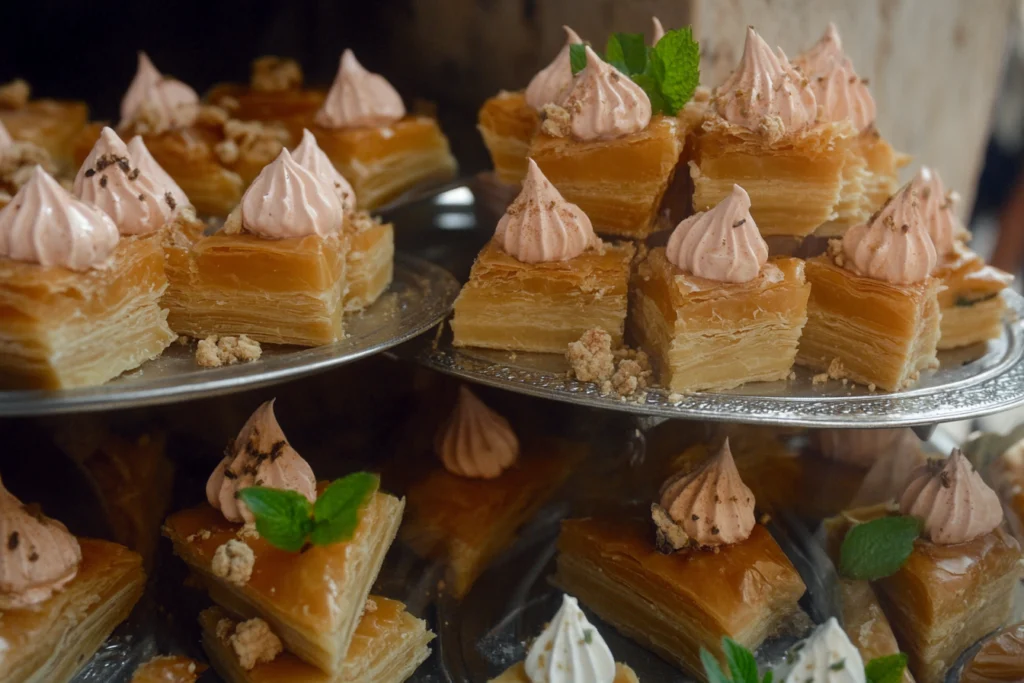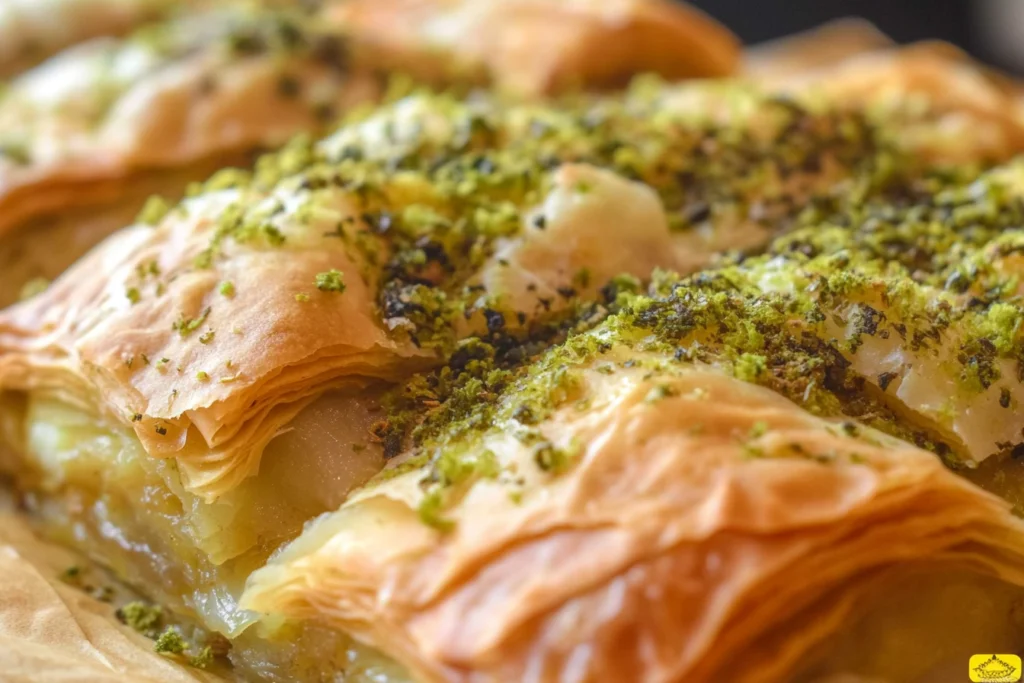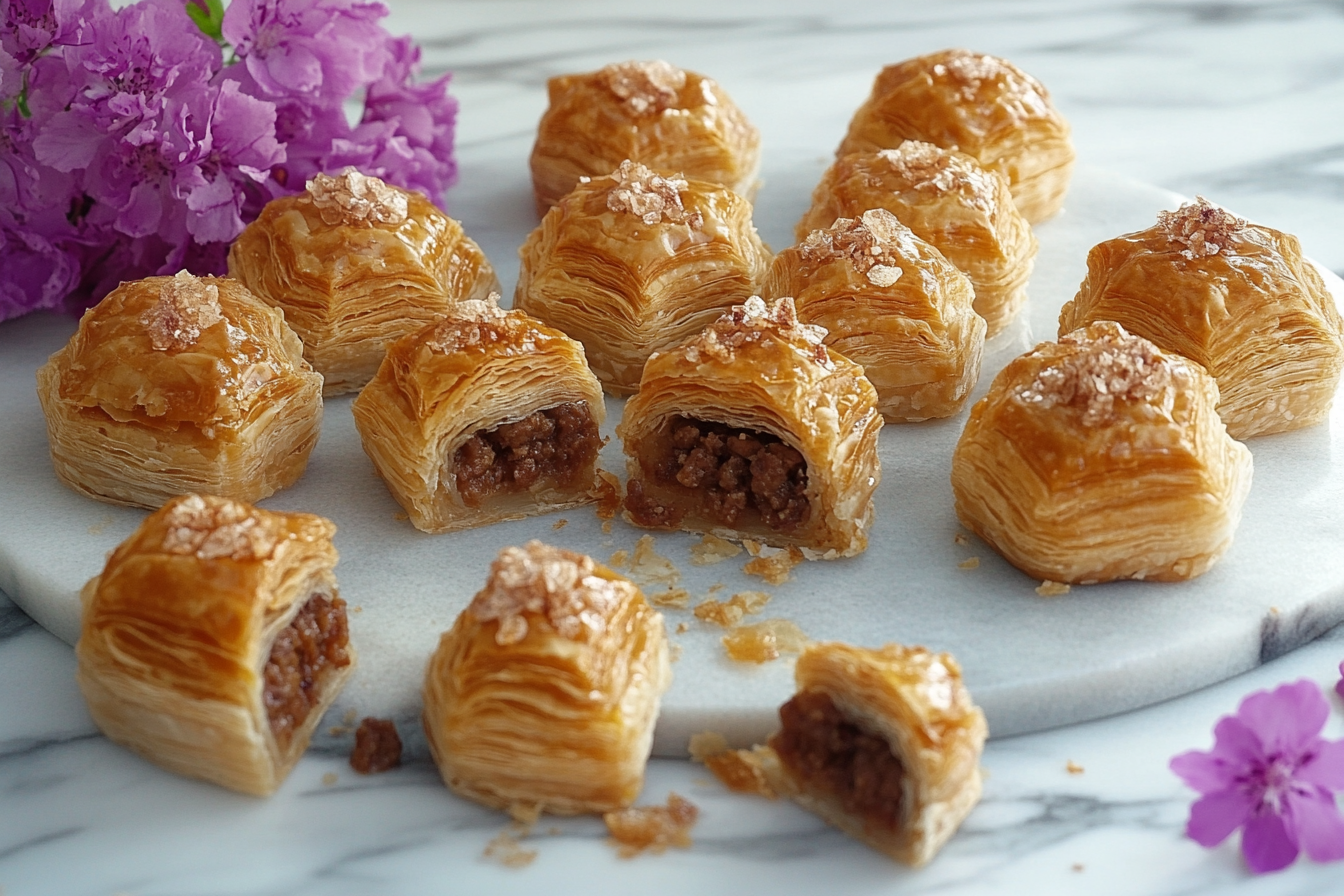Is Baklava Greek or Arab? This question has sparked debate for centuries among food historians, chefs, and enthusiasts worldwide. Baklava, a beloved dessert known for its rich, buttery layers and sweet syrup, has deep roots in both Greek and Arab culinary traditions. To understand its true origins, we must explore its history, cultural significance, and culinary evolution.
Introduction to Baklava’s Origins
What is Baklava?
Baklava is a sweet pastry made with layers of delicate phyllo dough, filled with chopped nuts, and soaked in syrup or honey. Its delicate texture and tantalizing sweetness make it a dessert enjoyed across cultures. While its popularity is universal, the origins of baklava remain a topic of heated debate.
A Sweet Treat with Complex History
Baklava’s complex history reflects the blending of culinary traditions from ancient empires, trade routes, and migration. Its recipe evolved over centuries, absorbing influences from various regions, yet retaining its unique appeal. Both Greeks and Arabs claim baklava as their own, attributing its development to their respective culinary traditions.
The Debate: Greek or Arab?
This debate centers on historical records and cultural practices:
- Greek Argument: Greeks claim that baklava’s origins lie in the Byzantine Empire, a successor of the Greek-dominated Eastern Roman Empire. They argue that their innovation of thin phyllo dough was integral to baklava’s creation.
- Arab Perspective: Arabs assert that baklava traces back to the Levant and Mesopotamia, regions with a rich history of confectionery, where nuts and honey were staples in desserts.
Earliest Mentions of Baklava in Historical Records
The origins of baklava can be traced to early culinary texts. Some historians link it to the Assyrian Empire (8th century BCE), where a similar pastry was prepared using unleavened bread layered with nuts and honey. However, written records from the Byzantine and Ottoman periods showcase its evolution into the baklava we recognize today.
Influence of the Ottoman Empire on Baklava’s Spread
The Ottoman Empire played a pivotal role in baklava’s widespread popularity. As the empire expanded, baklava became a symbol of wealth and refinement, served in palaces and at significant events. Ottoman bakers perfected phyllo dough, a critical component of baklava, and spread this dessert throughout their territories, influencing both Greek and Arab cuisines.
Regional Variations in Baklava Recipes
Baklava is not a monolith; its recipes vary greatly based on geography:
- Greek Variations: Typically include honey for sweetness and emphasize simplicity.
- Arab Variations: Use sugar syrups flavored with rose water or orange blossom, giving the dessert a distinctive fragrance.
- Turkish Variations: Often incorporate pistachios and are characterized by extreme precision in dough preparation.
The Role of Geography in Culinary Traditions
Ancient Desserts Similar to Baklava
Before baklava became a culinary staple, similar desserts existed across the ancient world:
- Roman Placenta Cake: Made with layers of dough and honey.
- Persian Baklawa: Included nuts and spices, resembling the flavors of modern baklava.
- Egyptian Feteer: A flaky pastry that shares textural similarities with baklava.
These desserts reveal how culinary traditions often overlap and evolve through cultural exchanges.
Evolution of Phyllo Pastry and Sweet Syrups
Phyllo dough, meaning “leaf” in Greek, was first documented during the Byzantine era. This innovation enabled bakers to create ultra-thin layers essential for baklava. Similarly, syrups made from honey or sugar were widely used in both Greek and Arab cuisines, underscoring the shared roots of this dessert.
Trade Routes and Cultural Exchange in Baklava’s History
The Silk Road and Mediterranean trade routes facilitated the exchange of spices, nuts, and culinary ideas. Ingredients like pistachios and rose water traveled from the East, influencing baklava’s flavor profile. This interconnectedness highlights how baklava became a shared cultural artifact rather than the exclusive property of one group.
Conclusion to Part 1
Baklava’s history is a tapestry woven from multiple cultures, shaped by geography, trade, and empire. While the debate over its origins remains unresolved, one thing is clear: baklava embodies the richness of shared culinary heritage.
Is Baklava Greek or Arab? (Part 2)
Continuing from Part 1, we now delve deeper into baklava’s connections to Greek culture and traditions. Examining its role in Greek festivals, unique ingredients, and baking techniques reveals how this dessert has become a cherished symbol of Greek heritage.
Greek Connection to Baklava
Baklava in Greek Culture and Traditions
In Greek culture, baklava is more than a dessert; it’s a symbol of celebration and hospitality. Served at weddings, religious holidays, and family gatherings, baklava holds a special place on festive tables. Its association with communal joy makes it a quintessential part of Greek identity.
- Easter Celebrations: Baklava is often prepared during Orthodox Easter, symbolizing abundance and shared blessings.
- Weddings: In traditional Greek weddings, baklava is served as a sweet conclusion, signifying prosperity for the newlyweds.
Greek Festivals and Occasions Featuring Baklava
Baklava features prominently during key Greek festivals, including:
- Panigiria (Local Feasts): Often served alongside other traditional sweets.
- Christmas: Baklava adds sweetness to festive tables, often enhanced with cinnamon or clove for a warm, seasonal flavor.
- Name Days: A traditional Greek celebration of saints’ feast days, where baklava is a common offering.
These occasions underline baklava’s role as a culinary representation of joy and togetherness.
Unique Greek Ingredients in Baklava
Greek baklava incorporates distinct ingredients that set it apart from other variations:

- Honey: Unlike sugar syrups used in Arab recipes, Greek baklava relies on honey for its characteristic sweetness.
- Walnuts: While pistachios dominate Middle Eastern versions, Greek baklava often uses walnuts, reflecting local agricultural practices.
- Cinnamon and Cloves: These spices add a warm and aromatic dimension to Greek baklava.
The Role of Honey and Nuts in Greek Recipes
Honey has deep roots in Greek culinary traditions, dating back to antiquity when it was considered the “nectar of the gods.” Combined with locally sourced nuts, it creates a flavor profile that is uniquely Greek. This combination also mirrors ancient Greek desserts, emphasizing simplicity and natural flavors.
Influence of the Byzantine Empire on Greek Baklava
The Byzantine Empire, a bridge between ancient and medieval worlds, significantly influenced Greek baklava. The Byzantines inherited Roman culinary traditions, which included layered desserts resembling baklava. They refined these recipes by incorporating local ingredients and techniques, laying the groundwork for modern Greek baklava.
- Phyllo Dough Innovation: Byzantine bakers developed thinner, more pliable layers of dough, a precursor to the phyllo used today.
- Use of Honey Syrup: This sweetener was prevalent in Byzantine cuisine, marking a continuity from ancient Greek traditions.
Mythology and Symbolism Associated with Baklava in Greece
Baklava’s layers are sometimes likened to the complexity of human emotions or the layered nature of life itself. Greek mythology, rich with symbolism, often ties food to divine narratives. While there’s no direct mythological reference to baklava, its use of honey and nuts echoes offerings made to gods in ancient rituals.
Modern Greek Variations of Baklava
Contemporary Greek baklava continues to evolve, with regional and personal variations:
- Cretan Style: Uses locally sourced thyme honey and almonds.
- Northern Greek Variations: Incorporate hazelnuts or a mix of walnuts and almonds.
- Chocolate Baklava: A modern twist, blending traditional flavors with cocoa.
These adaptations demonstrate the versatility and enduring popularity of baklava in Greek cuisine.
Techniques and Tools Unique to Greek Bakers
Greek bakers take pride in their craftsmanship, employing traditional techniques and tools to create baklava:
- Handmade Phyllo Dough: Rolled thin enough to see through, requiring exceptional skill and patience.
- Layering Precision: Greek bakers meticulously alternate layers of phyllo and nuts to achieve perfect texture.
- Clay or Metal Baking Trays: Often used to ensure even heat distribution.
These techniques, passed down through generations, preserve the authenticity of Greek baklava.
Baklava in Greek-American Communities
Greek immigrants brought baklava to the United States, where it became a staple in Greek-American bakeries and festivals. Over time, it adapted to local tastes:
- Influence of American Palates: Many Greek-American versions incorporate additional spices or flavors like vanilla.
- Cultural Events: Greek festivals across the U.S. showcase baklava as a highlight of their culinary offerings, introducing it to a broader audience.
Role of Religion in Shaping Baklava Traditions
Religion plays a pivotal role in baklava’s prominence within Greek culture. Its preparation is often linked to Orthodox Christian holidays, such as:
- Christmas and Easter: Where it symbolizes divine sweetness and blessings.
- Fasting Periods: Adaptations of baklava without butter cater to religious fasting rules, making it a versatile dessert.
Conclusion to Part 2
Baklava’s integration into Greek culture is evident in its festivals, traditions, and culinary techniques. While its historical roots may intertwine with other regions, Greece has undeniably made baklava its own through unique ingredients, flavors, and practices.
Is Baklava Greek or Arab? (Part 3)
In this final part, we focus on the Arab roots of baklava. By examining its role in Arab cuisine, cultural traditions, and historical records, we uncover how the Arab world has shaped the identity and evolution of this beloved dessert.
Arab Connection to Baklava
Baklava in Arab Cuisine
Baklava is deeply embedded in Arab culinary culture. In the Arab world, it is a staple dessert served during special occasions, family gatherings, and festive celebrations. Its sweet and nutty profile, enriched by floral syrups, reflects the region’s penchant for bold yet balanced flavors.
- Eid Celebrations: Baklava is a centerpiece dessert during Eid al-Fitr and Eid al-Adha, symbolizing joy, generosity, and the sweetness of life.
- Weddings and Births: Often included in dessert spreads, baklava represents prosperity and blessings.
Arab baklava variations emphasize richness, with each bite offering a luxurious blend of textures and aromas.
How Arab Confectionery Influenced Baklava
Arab influence on baklava is evident in the techniques, flavors, and presentation unique to Middle Eastern desserts:
- Layering Techniques: Mastery of layering delicate dough, combined with nuts and syrups, is a hallmark of Arab baklava.
- Use of Rose and Orange Blossom Water: These ingredients give Arab baklava its signature floral fragrance, elevating it beyond a simple pastry.
- Flavor Complexity: Arab baklava often balances the sweetness of sugar syrups with subtle spices, such as cinnamon, cardamom, and cloves.
These innovations reflect the culinary sophistication of Arab cooks, who elevated baklava to an art form.
Common Ingredients in Arab Baklava
Arab baklava recipes emphasize locally sourced, high-quality ingredients:
- Pistachios: Often used in Levantine baklava for their vibrant green color and rich taste.
- Almonds and Walnuts: Frequently combined with pistachios or used alone in other Arab regions.
- Sugar Syrup with Citrus: A defining feature of Arab baklava, syrups are infused with lemon juice for balance and occasionally spiced with floral essences.
- Ghee (Clarified Butter): Adds richness to the phyllo layers, enhancing the dessert’s indulgent texture.
These ingredients demonstrate how baklava adapts to local tastes while maintaining its core identity.

aklava Across the Arab World: Regional Twists
The diversity of baklava in the Arab world highlights its adaptability and regional creativity. Each region has made this dessert its own by incorporating unique flavors and techniques.
- Lebanon and Syria: These regions are renowned for their intricate phyllo layers, which are paired with generous amounts of rose water and pistachios to create a distinctly aromatic dessert. Furthermore, their baklava is often lighter and more delicately flavored.
- Jordan and Palestine: In contrast, baklava from these areas typically includes a blend of nuts and relies on simpler, less spiced syrups. This subtle flavor profile makes it particularly appealing to those who prefer less sweetness.
- Egypt: Egyptian baklava stands out for its thicker layers of dough and a heavier syrup, which give it a denser, more indulgent texture. Additionally, local sweeteners like molasses are sometimes used for variation.
- Arabian Gulf: Meanwhile, baklava in the Gulf region reflects South Asian trade influences. It blends traditional techniques with saffron and cardamom, producing a distinctive flavor that is both rich and exotic.
Clearly, these variations demonstrate not only the dessert’s flexibility but also the deep sense of regional pride and innovation that baklava inspires across the Arab world.
Historical Evidence Supporting Arab Roots
Historical records strongly support the Arab claim to baklava, providing a wealth of evidence that ties the dessert to ancient culinary traditions and innovations.
- Abbasid Era Cookbooks: These medieval texts from the Islamic Golden Age describe layered pastries filled with nuts and sweetened with syrups. These early recipes bear a striking resemblance to baklava’s core components, showcasing the Arabs’ early mastery of such desserts.
- Mesopotamian and Persian Influence: Ancient culinary practices in the Fertile Crescent featured layered breads, honey, and nuts. These elements clearly prefigure the modern form of baklava, highlighting how ancient Arab regions contributed to its evolution.
- Ottoman Adaptations: Later, the Ottoman Empire adopted and popularized baklava, spreading it across its territories. Importantly, the Ottomans inherited these recipes from the Arab world, standardizing techniques while preserving the dessert’s distinct Middle Eastern identity.
Together, these historical touchpoints underscore the deep cultural and culinary connection between baklava and the Arab world, affirming its status as a shared legacy within the broader Middle Eastern tradition.
Significance of Baklava in Arab Festivals
Baklava is a symbol of celebration and hospitality in Arab culture. Its presence during major festivals reflects its importance:
- Eid al-Fitr: Concludes Ramadan with sweet indulgence, symbolizing gratitude and joy.
- Eid al-Adha: Shared among families and communities, reinforcing bonds of generosity and togetherness.
- Weddings and Celebratory Feasts: Baklava represents abundance and well-wishing for the future.
Its role in these events highlights its emotional and cultural significance.
Techniques Passed Down Through Generations
In Arab households, baklava-making is a deeply personal and generational craft:
- Handmade Phyllo Dough: Many families still prepare phyllo from scratch, requiring patience and skill to achieve the desired thinness.
- Layering Precision: Arab bakers meticulously alternate layers of dough and nuts to create a harmonious balance of textures.
- Flavor Customization: Families often add unique touches, such as specific spice blends or syrup flavors, creating recipes that are passed down as treasured heirlooms.
These techniques preserve the authenticity and artistry of Arab baklava, ensuring its legacy endures.
Cultural Pride and Baklava’s Symbolic Role
Baklava in the Arab world is not just a dessert; it is a symbol of identity and pride. Sharing baklava is an act of hospitality and generosity, reflecting core values of Arab culture. It serves as a reminder of the region’s rich culinary heritage and its ability to bring people together through food.
Conclusion to Part 3
The Arab connection to baklava is as profound as it is enduring. From its early roots in ancient Mesopotamia to its prominence in modern Middle Eastern cuisine, Arab baklava showcases the region’s culinary artistry and cultural richness. Whether Greek or Arab, baklava stands as a testament to the shared culinary history that transcends borders.

